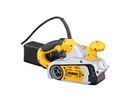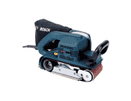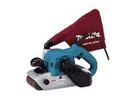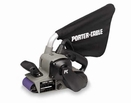The Facts About Belt Sanders
With two parallel spinning drums on its underside powering the continuous motion of a sanding belt, a belt sander is a brilliant power tool designed to efficiently sand and level any number of industrial materials. Belt sanders are a much rougher tool than most sanders and are generally only used for the most demanding quick removal or rough surface leveling or removal projects. The most conventional belt sanders use 3″ to 4 ” wide belts offering greater working surface area and sacrificing a bit of controllability. It’s easy to make avoidable errors when working with a belt sander; it takes only one moment to lose control or remove too much material. Of course the same is true of motor size, the more amps you have, the more power you have to control. So essentially, operators should be comfortable and cautious with their belt sanders; the precision of finish sanding, for example, is pretty difficult to achieve with one of these bulky power tools.
Maintenance: The larger build of belt sanders, however, helps them withstand some pretty serious shop abuse. They are tough and general maintenance is relatively simple. Mostly you just need to be certain the two cylindrical rollers (drums) the sanding belt sits on remain in perfect alignment. If the rollers are not precisely parallel, the belt will not track in the center of the rollers and will slip off. As a rule, you should try to adjust the rollers each time you change the belt. This can be done with a manual tracking knob on the side of the tool. If your drums are tilted the belt will either push toward the inside of the rollers or slip off of them altogether. If the rollers are poorly aligned, they can also push the belt up toward the housing which could cause damage to both the housing and the belt.
It’s also important to check the platen for wear, dents or scratches when changing the belt. The platen is a thin piece of metal backed with a similarly thin sheet of cork. It sits (on the underside of the sander) between the inside of the sanding belt and the sander’s shoe. It’s there to afford a flat but also somewhat soft support, or shock absorption, for the sander and the belt as well. Because the belt rubs over the platen, it’s important to watch for wear; the platen will eventually need to be replaced due to this friction. You may consider removing the platen periodically to make certain the cork is still intact. When the cork begins to crumble apart, or the metal begins the thin, the platen must be replaced.
Changing the Belt: To change the belt, flip the sander onto one side leaving the open side facing up, pull the release handle and the rollers will come slightly together to slacken the belt. Before replacing the belt be certain it is facing the direction indicated (by arrows) on the bottom of the belt – otherwise your sandpaper will be moving in the wrong direction. Slide the belt over the rollers and drop the handle to tighten the belt to the drums. Align the rollers with the sander’s tracking knob to ensure they are exactly parallel. The sander must be engaged to adjust the tracking so be certain the sander is secure before making any adjustments. The sander may face either up or down as you adjust the tracking, but it’s generally easier to do effectively if you can see the belt as you adjust. The belt should track in the center of both the rollers and the platen, but if you run into a stubborn belt, just be sure it tracks in the center of the rollers.
As all craftsmen know, a great deal of sawdust comes along with sanding. It’s vitally important to keep all your power tools clean, so be certain to blow out your sander periodically (even after every use) to keep it running smooth and efficient. If your belt sander is corded be sure to check it for breakage and replace replace it if damage occurs.
Though belt sanders have a tendency to be rough, don’t let their aggressive power deter you form using them – simply be slow and cautious as you work and you’ll find that for many projects the performance of a belt sander is totally incomparable.
For more information on a specific belt sander you may like the Makita 9404 belt sander, Dewalt DW432 belt sander, or the Porter-Cable 352VS belt sander.

















